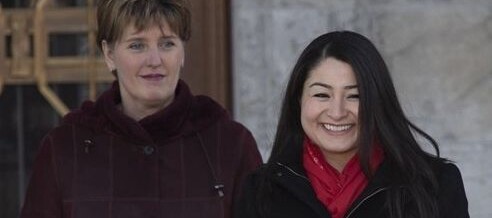
McLeod Group guest blog by Liam Swiss, April 4, 2019
Whether blamed on Scott Brison’s retirement or the SNC-Lavalin affair, the revolving door of Trudeau Cabinet shuffles and resignations over the past months has heads spinning. A move that attracted little attention outside the development community was the departure of Marie-Claude Bibeau from the international development portfolio.
Bibeau’s appointment as Minister of International Development in Trudeau’s “Because it’s 2015” gender-balanced cabinet was a safe choice. Though a political novice, she has some professional experience in international development. Bibeau embraced her ministry and, by all accounts, thrived in the position.
Bibeau’s term will be closely associated with the Feminist International Assistance Policy (FIAP) adopted in 2017. Since that policy focuses on gender equality and the rights of women and girls, it is perhaps not surprising that Maryam Monsef, already Minister for Women and Gender Equality, was named as Bibeau’s successor as Minister of International Development.
The new minister has a grounding in feminist approaches in her existing cabinet role and experience with Canadian development efforts in Afghanistan. Still, the arrival of a new minister with a double portfolio for the very short period of time before the next federal election raises challenges for Global Affairs Canada and its aid program, including flattening the ministerial learning curve, capturing divided attention, and avoiding pre-election doldrums.
Learning Curves
The aid program is a complex portfolio and presents a steep learning curve for most new ministers. While Monsef is well versed in the feminist approach of the FIAP, this does not necessarily mean she is prepared for the operational requirements of disbursing billions of dollars of Canadian aid.
Bibeau’s departure has no doubt pushed the aid bureaucracy into a frenzied preparation of briefing books and orientation sessions for Monsef and her staff. But this process comes at the worst time in the annual cycle of aid planning and programming: at the end of the government’s fiscal year, when millions of Canadian aid dollars must be approved and disbursed. The worst-case scenario of the unexpected change in minister at this time of year is that a steep learning curve immobilizes the year-end programming approvals, leading Canada to miss its spending targets and having to return aid funds to the treasury. Given lacklustre aid levels in recent years, any barriers to spending in a timely manner will further harm Canada’s reputation as a reliable aid partner.
Divided Attention
It remains to be seen whether one minister can give adequate attention to two portfolios. Though the feminist policy frameworks underpinning both ministries might make this simpler, the ability to physically be present for both portfolios simultaneously will be challenging. The new portfolio adds to Monsef’s existing Cabinet duties, so international development officials will need to deftly adapt to having a minister with less time and attention available to accomplish the same objectives expected of the aid program when it had its own dedicated minister.
Pre-Election Doldrums
The final challenge will be to ensure that the feminist agenda continues to unfold as planned. Sceptics might think that Monsef is little more than a caretaker minister to bring the aid program through to the next election. If this proves to be the case, the development community might be rightly concerned about what will be accomplished in the aid program in the run-up to the 2019 election. If Monsef does not want to make waves between now and a fall election, the risk of a period of doldrums for Canada’s aid program is high.
Budget 2019 did nothing to dispel this notion, with no new funds committed to the aid in the short term. Canada’s aid program will therefore probably remain in a holding pattern until after the election. Liberal supporters might hope that Monsef’s tenure will be an audition for the same position in the next government, but if she is not returned to cabinet, or – as is seeming increasingly possible – the Liberals are not returned to government, there will be a new Minister of International Development again, bringing the ministerial learning curve right back into the picture.
The recent cabinet shuffles will be remembered for much more than the departure of Marie-Claude Bibeau from the international development portfolio, but in Canada’s international development community, this is the change being most closely watched. If Global Affairs Canada reduces the ministerial learning curve, captures sufficient attention from an overburdened minister, and continues to implement its feminist agenda, the impact of the cabinet shuffle may prove trivial. To be sure, Monsef will play the pivotal role in making all this happen. Leaving Bibeau in this post until the 2019 election would have been a surer bet, but in politics, as in foreign aid, it seems like there is no such thing as a sure bet.
Liam Swiss is an associate professor in the Department of Sociology at Memorial University. Photo of Minister of Agriculture and Agri-Food Marie-Claude Bibeau and Minister of International Development and Minister for Women and Gender Equality Maryam Monsef: The Canadian Press/Justin Tang.
